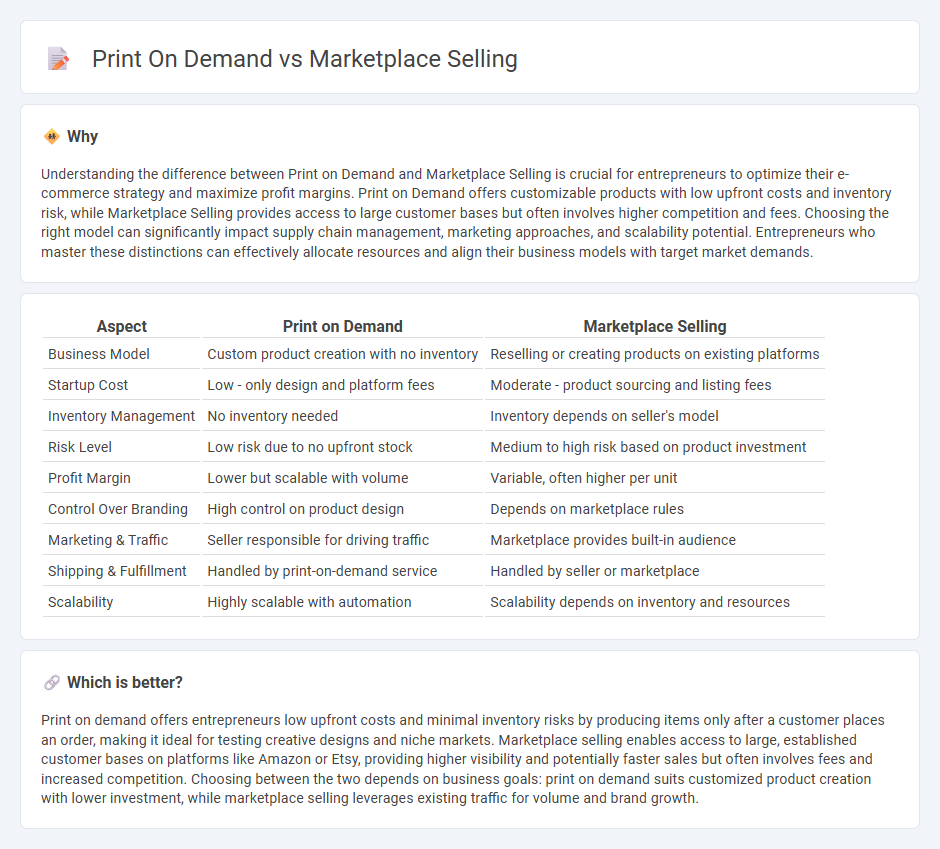
Print on demand allows entrepreneurs to create and sell custom products without inventory, minimizing upfront costs and automating fulfillment. Marketplace selling offers access to established customer bases on platforms like Amazon or Etsy, enabling rapid market entry but often involves higher fees and competition. Explore these models further to determine which strategy best aligns with your business goals.
Why it is important
Understanding the difference between Print on Demand and Marketplace Selling is crucial for entrepreneurs to optimize their e-commerce strategy and maximize profit margins. Print on Demand offers customizable products with low upfront costs and inventory risk, while Marketplace Selling provides access to large customer bases but often involves higher competition and fees. Choosing the right model can significantly impact supply chain management, marketing approaches, and scalability potential. Entrepreneurs who master these distinctions can effectively allocate resources and align their business models with target market demands.
Comparison Table
| Aspect | Print on Demand | Marketplace Selling |
|---|---|---|
| Business Model | Custom product creation with no inventory | Reselling or creating products on existing platforms |
| Startup Cost | Low - only design and platform fees | Moderate - product sourcing and listing fees |
| Inventory Management | No inventory needed | Inventory depends on seller's model |
| Risk Level | Low risk due to no upfront stock | Medium to high risk based on product investment |
| Profit Margin | Lower but scalable with volume | Variable, often higher per unit |
| Control Over Branding | High control on product design | Depends on marketplace rules |
| Marketing & Traffic | Seller responsible for driving traffic | Marketplace provides built-in audience |
| Shipping & Fulfillment | Handled by print-on-demand service | Handled by seller or marketplace |
| Scalability | Highly scalable with automation | Scalability depends on inventory and resources |
Which is better?
Print on demand offers entrepreneurs low upfront costs and minimal inventory risks by producing items only after a customer places an order, making it ideal for testing creative designs and niche markets. Marketplace selling enables access to large, established customer bases on platforms like Amazon or Etsy, providing higher visibility and potentially faster sales but often involves fees and increased competition. Choosing between the two depends on business goals: print on demand suits customized product creation with lower investment, while marketplace selling leverages existing traffic for volume and brand growth.
Connection
Print on demand enables entrepreneurs to create customized products without inventory costs, seamlessly integrating with marketplaces like Etsy and Amazon for global reach and automated order fulfillment. Marketplace selling leverages this model by providing established customer bases and streamlined logistics, enhancing scalability for small businesses. This connection reduces upfront investment and risk, empowering entrepreneurs to test designs and optimize offerings based on real-time market demand.
Key Terms
Inventory Management
Marketplace selling requires maintaining accurate inventory across multiple platforms to prevent stockouts or overselling, often involving complex synchronization tools. Print on demand eliminates inventory concerns by producing items only after a customer places an order, streamlining stock management and reducing upfront costs. Discover more about how these models impact your business efficiency and scalability.
Product Customization
Product customization in marketplace selling is often limited by the platform's preset options and policies, restricting sellers' ability to offer personalized goods. Print on demand services excel by allowing customers to create unique designs on a wide range of products, enhancing user engagement and satisfaction. Explore how print on demand can transform your product offerings with advanced customization capabilities.
Fulfillment Methods
Marketplace selling often utilizes third-party fulfillment centers or seller-handled inventory, enabling faster shipping and bulk storage options. Print on demand relies on on-demand production paired with direct shipping from printers, reducing upfront inventory costs but potentially extending delivery times. Explore deeper insights into fulfillment strategies to optimize your e-commerce operations.
Source and External Links
How to sell on Facebook Marketplace for beginners - Facebook Marketplace selling involves creating a personal profile, preparing high-quality listings with photos and detailed descriptions, setting competitive prices, and choosing the right category to connect with buyers locally or via ecommerce integrations.
How to Sell on Facebook Marketplace - The process to sell on Facebook Marketplace includes logging in, creating a new listing with photos, setting a title and price, picking category and condition, writing a description, setting delivery preferences, and publishing the listing.
22 Selling Websites and Marketplaces for Selling Things - Facebook Marketplace is a popular local online selling site with no fees for listings, used by millions monthly, ideal for individuals to reach an active audience and can be integrated with eCommerce platforms like Shopify for business scale selling.
 dowidth.com
dowidth.com